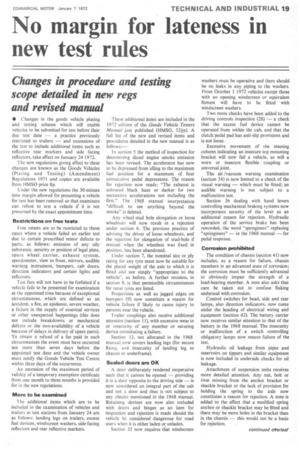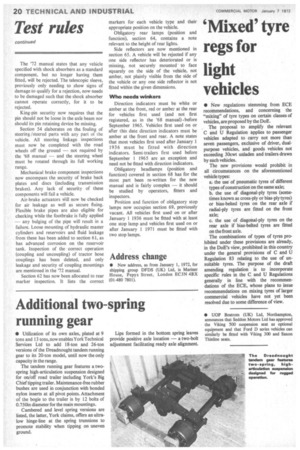Changes in procedure and testing scope detailed in new regs and revised manual
Page 21

Page 22

If you've noticed an error in this article please click here to report it so we can fix it.
• Changes in the goods vehicle plating and testing scheme which wilt enable vehicles to be submitted for test before their due test date — a practice previously restricted to trailers — and extensions of the test to include additional items such as reflective rear markers and side facing reflectors, take effect on January 24 1972.
The new regulations giving effect to these changes are known as the Goods Vehicles (Plating and Testing) (Amendment) Regulations 1971 and copies are available from HMSO price 8p.
Under the new regulations the 30-minute time margin allowed for presenting a vehicle for test has been removed so that examiners can refuse to test a vehicle if it is not presented by the exact appointment time.
Restrictions on free tests
Free retests are to be restricted to those cases where a vehicle failed an earlier test due to certain prescribed minor defects to parts, as follows: emission of any oily substance, security or position of legal plate, spare wheel carrier, exhaust system, speedometer, view to front, mirrors, audible warning instrument, bumpers, cab doors, direction indicators and certain lights and reflectors.
Test fees will not have to be forfeited if a vehicle fails to be presented for examination at the appointed time because of exceptional circumstances, which are defined as an accident, a fire, an epidemic, severe weather, a failure in the supply of essential services or other unexpected happenings (this does not include breakdowns or mechanical defects or the non-availability of a vehicle because of .delays in delivery of spare parts). To obtain a refund of a fee paid in such circumstances the event must have occurred not more than seven days before the appointed test date and the vehicle owner must notify the Goods Vehicle Test Centre within three days of the occurrence.
An extension of the maximum period of validity of a temporary exemption certificate from one month to three months is provided for in the new regulations.
More to be examined
The additional items which are to be included in the examination of vehicles and trailers at test stations from January 24 are as follows: landing legs on trailers, excess fuel devices, windscreen washers, side-facing reflectors and rear reflective markers.
These additional items are included in the 1972 edition of the Goods Vehicle Testers Manual just published (HMSO, 321p). A full list of the new and revised items and procedures detailed in the new manual is as follows:—
In section 5 the method of inspection for determining diesel engine smoke emission has been revised. The accelerator has now to be depressed from idling to the maximum fuel position for a maximum of four consecutive pedal depressions. The reason for rejection now reads: "The exhaust is coloured black haze or darker for two successive accelerations not including the first." The 1968 manual interpretation "difficult to see anything beyond the smoke" is deleted.
Any wheel-stud hole elongation or loose wheelnuts will now result in a rejection under section 6. The previous practice of advising the driver of loose wheelnuts, and the rejection for elongation of stud-hole if noticed when the• wheelnut was fixed in position, has.been abandoned.
Under section 7, the nominal size or ply rating for any tyre must now be suitable for the plated weight of the axle to which it is fitted and not simply "appropriate to the vehicle-, as before. A further revision, in section 8, is that permissible circumstances for recut Lyres are listed.
Projections as well as jagged edges on bumpers (9) now constitute a reason for vehicle failure if likely to cause injury to persons near the vehicle.
Trailer couplings also receive additional attention (section 11), with excessive wear in or insecurity of any member or securing device constituting &failure.
Section 13, not allocated in the 1968 manual, now covers landing legs (for secure fixing, and insecurity of landing leg to chassis or underframe).
Sealed doors are OK
A door deliberately rendered inoperative such that it cannot be opened — providing it is a door opposite to the driving side — is now considered an integral part of the cab and not a door and thus is not subject to any checks mentioned in the 1968 manual. Retaining devices are now also included with doors and hinges as an item for inspection and rejection is made should the vehicle be considered dangerous for road users when it is either laden or unladen.
Section 25 now requires that windscreen
washers must be operative and there should be no leaks-in any piping to the washers. From October 1 1972 vehicles except those with an opening windscreen or equivalent fitment will have to be fitted with windscreen washers.
Two more checks have been added to the driving controls inspection (28) — a check that the excess fuel device cannot be operated from within the cab, and that the clutch pedal pad has anti-slip provisions and is not loose.
Excessive movement of the steering column indicating an insecure top mounting bracket will now fail a vehicle, as will a worn or insecure flexible coupling or universal joint.
The air /vacuum warning examination (section 34) is now limited to a check of the visual warning — which must be fitted; an audible warning is not subject to a malfunction test.
Section 36 dealing with hand levers controlling mechanical braking systems now incorporates security of the lever as an additional reason for rejection. Hydraulic operation of the service brake has been reworded, the word "sponginess" replacing "springiness" — in the 1968 manual — for pedal response.
Corrosion prohibited
The condition of chassis (section 41) now includes, as a reason for failure, chassis members in an advanced state of corrosion; the corrosion must be sufficiently advanced to obviously impair the strength of a load-bearing member. A note also asks that care be taken not to confuse flaking undersea! with corrosion.
Control switches for head, side and rear lamps, also direction indicators, now come under the heading of electrical wiring and equipment (section 42). The battery carrier now receives similar attention to that of the battery in the 1968 manual. The insecurity or malfunction of a switch controlling obligatory lamps now means failure of the test.
Hydraulic oil leakage from pipes and reservoirs on tippers and similar equipment is now included in underside checks for oil leakage.
Attachment of suspension units receives more detailed attention. Any nut, bolt or rivet missing from the anchor bracket or shackle bracket or the lack of provision for holding the spring to the axle now constitutes a reason for rejection. A note is added to the effect that a modified spring anchor or shackle bracket may be fitted and there may be more holes in the bracket than in the chassis — this would not be a basis for rejection. . The '72 manual states that any vehicle specified with shock absorbers as a standard component, but no longer having them fitted, will be rejected. The telescopic sleeve, previously only needing to show signs of damage to qualify for a rejection, now needs to be damaged such that the shock absorber cannot operate correctly, for it to be rejected.
King-pin security now requires that the pin should not be loose in the axle beam nor should its pin retaining device be missing.
Section 54 elaborates on the, fouling of steering /steered parts with any part of the vehicle. All steering linkage inspections must now be completed with the road wheels off the ground — not required by the '68 manual — and the steering wheel must be rotated through its full working range.
Mechanical brake component inspections now encompass the security of brake back plates and discs (including transmission brakes). Any lack of security of these components will fail a vehicle.
Air-brake actuators Will now be checked for air leakage as well as secure fixing. Flexible brake pipes are also eligible for checking while the footbrake is fully applied — any bulging of the pipe will result in a failure. Loose mounting of hydraulic master cylinders and reservoirs and fluid leakage from these has been added to section 61, as has advanced corrosion on the reservoir tank. Inspection of the correct operation (coupling and uncoupling) of tractor hose couplings has been deleted, and only leakage and security of coupling mountings are mentioned in the '72 manual.
Section 62 has now been allocated to rear marker inspection. It lists the correct markers for each vehicle type and their appropriate position on the vehicle.
Obligatory rear lamps (position and function), section 64, contains a note relevant to the height of rear lights.
Side reflectors are now mentioned in section 65. A vehicle will be rejected if any one side reflector has deteriorated or is missing, not securely mounted to face squarely on the side of the vehicle, not amber, not plainly visible from the side of the vehicle or any one side reflector is not fitted within the given dimensions.
Who needs winkers
Direction indicators must be white or amber at the front, red or amber at the rear for vehicles first used (and not first registered, as in the '68 manual) .before September 1965. Vehicles first used on or after this date direction indicators must be amber at the front and rear. A note states that most vehicles first used after January 1 1936 must be fitted with direction indicators. Semi-trailers first used before September I 1965 are an exception and need not be fitted with direction indicators.
Obligatory headlamps (position and function) covered in section 68 has for the most part been re-written for the new manual and is fairly complex — it should be studied by operators, fitters and inspectors.
Position and function of obligatory stop lamps now occupies section 69, previously vacant. All vehicles first used on or after January 1 1936 must be fitted with at least one stop lamp and vehicles first used on or after January 1 1971 must be fitted with two stop lamps.
Address, change
• New address, as from January 1, 1972, for shipping group DFDS (UK) Ltd, is Mariner House, Pepys Street, London EC3N 4BX (01-480 7801).




















































































